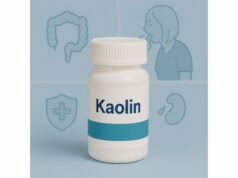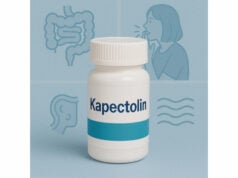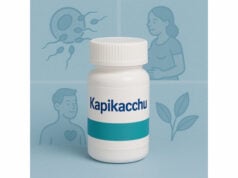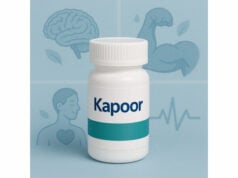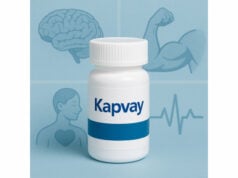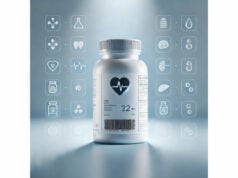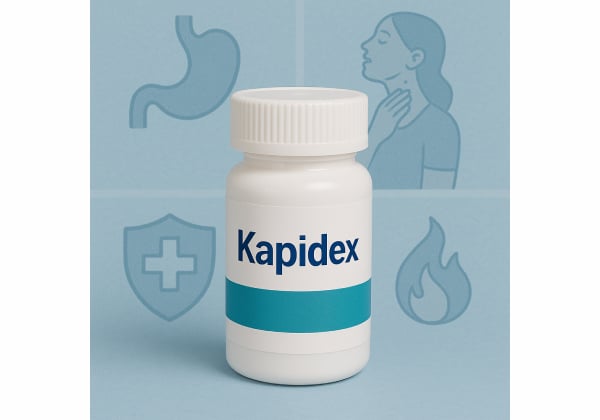
Kapidex is a former brand name for dexlansoprazole, a modern proton pump inhibitor (PPI) designed to control stomach acid and relieve persistent heartburn and gastroesophageal reflux disease (GERD). What makes dexlansoprazole distinctive is its dual delayed-release delivery: two sets of granules dissolve at different pH levels, extending acid suppression across the day and giving you more flexibility on when you take it. Adults and adolescents 12 years and older use it to heal erosive esophagitis, maintain healing, and treat troublesome heartburn even when endoscopy shows no erosions. Compared with older PPIs, dexlansoprazole can be taken without regard to meals, which helps if your schedule is unpredictable. Like all PPIs, benefits must be balanced with sensible, time-limited use and attention to potential long-term risks such as nutrient deficiencies or infections. This guide explains Kapidex/dexlansoprazole in plain language: how it works, when it’s the right choice, exact dosage ranges, interactions, red flags, and how to step down safely when symptoms are controlled.
Key Insights
- Dual delayed-release dexlansoprazole controls acid across the day and relieves frequent heartburn and GERD symptoms.
- Typical adult dosing: 30 mg once daily for heartburn for 4 weeks; 60 mg once daily up to 8 weeks to heal erosive esophagitis; 30 mg once daily for maintenance (duration varies by age).
- Use the lowest effective dose and reassess need regularly; prolonged high-dose PPI use may raise risks like C. difficile infection, low magnesium, and B12 deficiency.
- Avoid or seek specialist advice if taking rilpivirine, high-dose methotrexate, or certain HIV/antiplatelet drugs; adjust for moderate liver impairment.
Table of Contents
- What is Kapidex and how it works
- What benefits to expect and when
- How to take Kapidex correctly
- Timing, food, and common mistakes
- Safety, who should avoid, and interactions
- Evidence at a glance and FAQs
What is Kapidex and how it works
Kapidex was the original U.S. brand name for dexlansoprazole, later marketed as Dexlansoprazole delayed-release capsules. Regardless of brand, the active ingredient and clinical use are the same. Dexlansoprazole belongs to the proton pump inhibitor (PPI) class, which blocks the H⁺/K⁺-ATPase enzyme (the “proton pump”) that drives final acid secretion in stomach parietal cells.
What sets dexlansoprazole apart? Dual delayed release.
Traditional PPIs are highly timing-sensitive: you’re told to take them 30–60 minutes before breakfast so that drug levels peak when pumps activate. Dexlansoprazole uses two bead populations in the same capsule—one releases drug in the upper small intestine, the other later in the distal small intestine. The result is two plasma peaks several hours apart and a longer duration of acid control. In practical terms, many patients experience:
- Less time with intra-gastric pH <4 (meaning fewer acid “windows”).
- Flexible dosing with respect to meals and time of day.
- Smoother symptom control, including night-time heartburn for some people.
Approved uses (age ≥12 years):
- Healing erosive esophagitis (EE) up to 8 weeks.
- Maintenance of healed EE and relief of heartburn (duration limits differ for adults vs. adolescents).
- Symptomatic non-erosive GERD (heartburn relief for 4 weeks).
What patients typically notice:
- Within several days: fewer episodes of burning discomfort behind the breastbone, less regurgitation, and better sleep.
- By 4–8 weeks: improved ability to eat trigger foods in moderation and reduced need for rescue antacids.
- On maintenance therapy: sustained heartburn control—reassessed at planned intervals.
Where it fits among acid-reducing options:
- Antacids (fast but short acting) are for on-demand relief.
- H₂ blockers (e.g., famotidine) help with mild, intermittent symptoms or as bedtime add-ons.
- PPIs offer the most potent and durable acid suppression, with dexlansoprazole offering meal-independent convenience.
What dual release does not change:
- Dexlansoprazole still requires regular, daily use to reach steady symptom control.
- It will not reverse conditions unrelated to acid (e.g., functional heartburn).
- Alarm symptoms (trouble swallowing, bleeding, weight loss, anemia) always need prompt evaluation, not masking.
What benefits to expect and when
For frequent heartburn (non-erosive GERD):
Most patients taking 30 mg once daily for 4 weeks report fewer and milder heartburn episodes. Because dexlansoprazole is less tied to meal timing, people with shift work, irregular meals, or late dinners often find it easier to take consistently—an underrated driver of success. If you still need daily rescue antacids after two weeks, discuss dose optimization or alternative causes of chest discomfort with your clinician.
For erosive esophagitis (EE):
If endoscopy shows erosions or ulcers in the esophagus, the typical course is 60 mg once daily for up to 8 weeks. Healing rates are high across LA grades, and symptom relief tracks with mucosal healing. In those with severe baseline inflammation or persistent symptoms at 8 weeks, your clinician may extend therapy or consider a second evaluation.
Maintenance after healing:
Once erosions heal, many adults step down to 30 mg once daily to maintain healing and keep heartburn quiet. The maintenance interval varies; adults are commonly reviewed at 6 months to confirm need and lower the dose or frequency if possible. In adolescents (12–17 years), maintenance studies typically extend up to 16 weeks.
Night-time symptoms and meal independence:
The dual-release system produces a broader coverage curve, which may reduce nocturnal acid breakthrough in some people. Importantly, because timing with meals is more flexible, patients who struggled to “take 30 minutes before breakfast” with older PPIs often experience more consistent control on dexlansoprazole simply by taking it once daily at a regular time they can stick with.
Quality-of-life gains you can expect with effective therapy:
- Sleep: fewer awakenings from acid taste, cough, or burning.
- Diet: greater tolerance of moderate triggers (tomato, citrus, spicy dishes), though overeating still provokes symptoms.
- Function: less need to elevate the head of the bed or use rescue antacids multiple times per day.
- Reduced complications: sustained acid control reduces risk of recurrent erosions and strictures.
Limitations and appropriate expectations:
- Functional heartburn (acid levels normal, esophagus hypersensitive) may not respond; such patients often benefit more from neuromodulators or behavioral therapy.
- Extra-esophageal symptoms (chronic cough, hoarseness) have mixed responsiveness to PPIs; time-limited trials with objective testing are preferred over indefinite therapy.
- Obesity, large hiatal hernia, and severe regurgitation predict harder-to-control disease; escalation to surgical or endoscopic options may be appropriate after objective workup.
Measuring success:
Track heartburn days per week, nocturnal awakenings, antacid use, and any alarm features. Tools like a simple 7-day symptom diary or a phone note help your clinician fine-tune treatment and decide when to step down.
How to take Kapidex correctly
Who can use it: Adults and adolescents 12 years and older with GERD-related indications. It is not recommended for children under 12 years for these uses.
Standard regimens (capsules 30 mg and 60 mg):
- Heartburn in non-erosive GERD: 30 mg once daily for 4 weeks.
- Healing erosive esophagitis: 60 mg once daily for up to 8 weeks.
- Maintenance after healing (adults): 30 mg once daily; controlled studies typically extend up to 6 months before re-evaluation.
- Maintenance after healing (12–17 years): 30 mg once daily; controlled study intervals are up to 16 weeks.
Hepatic impairment:
- Moderate impairment (Child-Pugh B): For healing of EE, reduce to 30 mg once daily (up to 8 weeks).
- Severe impairment (Child-Pugh C): Not recommended.
- Mild impairment (Child-Pugh A): No adjustment usually needed.
Administration tips:
- Timing and food: Take without regard to meals. Choose a time you will remember daily (morning or evening).
- How to take: Swallow the capsule whole. If needed, you can open the capsule and sprinkle the granules on a tablespoon of applesauce or mix in water for oral syringe/NG-tube administration as instructed by your clinician or pharmacist—do not chew the granules.
- Missed dose: Take it when remembered on the same day. If it’s almost time for the next dose, skip the missed one. Do not double.
- Rescue options: It’s fine to use antacids for breakthrough symptoms. If you need them most days, ask about optimizing therapy.
When to step down or stop:
- After 4–8 weeks of control, many patients can reduce to the lowest effective dose, switch to on-demand use, or transition to an H₂ blocker for mild evening symptoms.
- People with complicated GERD (severe EE, Barrett’s esophagus after risk assessment, recurrent strictures) may require longer maintenance—this is individualized.
What to do if symptoms persist:
- Check adherence: Are you taking it daily?
- Assess triggers: Late heavy meals, alcohol, and large portions still provoke reflux even with a PPI.
- Consider dose timing: While meal timing isn’t required, taking at the same time every day improves stability.
- Seek evaluation: Persistent symptoms deserve a look for non-acid reflux, motility disorders, or cardiac causes of chest pain.
Storage and travel:
- Store at room temperature, dry area, original bottle or blister.
- For travel, keep a spare week’s supply in your carry-on. Because dose timing is flexible, crossing time zones is simpler—aim to take your daily dose within a 6–8-hour window of your usual time and then realign over two days.
Timing, food, and common mistakes
Common pitfalls and how to avoid them
- Assuming all PPIs must be pre-meal: With dexlansoprazole, meal timing is optional. Pick a consistent daily time you’ll follow long-term.
- Stopping too soon: Acid-injured tissue needs weeks to heal. Stopping after a few good days invites relapse. Complete the recommended course and then reassess.
- “Chasing” symptoms with on-demand PPI dosing: PPIs don’t work like antacids; they prevent acid production. Take dexlansoprazole daily during an active course.
- Ignoring alarm symptoms: Trouble swallowing, bleeding, black stools, vomiting, unexplained weight loss, anemia, or chest pain that could be cardiac are not “reflux to push through.” Get evaluated promptly.
- Overreliance without lifestyle basics: Even potent PPIs struggle against late, large, fatty meals. Anchor your evening routine: lighter dinner, avoid lying down within 3 hours after eating, and elevate the head of the bed for night-time symptoms.
- Stacking multiple acid suppressants unnecessarily: Doubling up PPIs or adding high-dose H₂ blockers around the clock rarely adds value and may complicate side effects. If you have persistent nocturnal symptoms, discuss a short, time-boxed H₂ blocker at bedtime or non-acid reflux strategies.
Diet and behavioral strategies that make medication work better
- Portion control: Smaller, earlier dinners reduce gastric volume and reflux episodes.
- Trigger awareness: High-fat fried foods, chocolate, peppermint, onions, tomato-based sauces, and citrus concentrate symptoms in many people.
- Weight management: Even a 5–10% weight reduction in people with overweight can meaningfully reduce reflux burden.
- Sleep positioning: Left-side sleeping and a 10–20 cm bed head elevation can reduce nocturnal reflux.
- Alcohol and caffeine: Moderate, rather than eliminate; note your own thresholds.
Special scenarios
- Shift work or erratic schedules: Dexlansoprazole’s meal independence is an advantage—set a repeating phone reminder at a time that is stable across shifts (e.g., after brushing teeth).
- Athletes: Heavy late-evening training and large post-workout meals can worsen reflux; move the main meal earlier and use protein sources that digest more easily.
- Concomitant pain therapy: NSAIDs can aggravate dyspepsia and bleeding risk. Discuss alternatives (acetaminophen when appropriate) and gastroprotection needs with your clinician.
Measuring progress pragmatically
- Keep a two-column log: daily dose time and symptom score (0–10). Within two weeks on a consistent schedule, you should see a downward trend if acid is the driver. Lack of progress is your cue to re-evaluate rather than self-escalate indefinitely.
Safety, who should avoid, and interactions
Common side effects (adults):
Diarrhea, abdominal pain, nausea, vomiting, flatulence, and upper respiratory tract infections are the most reported. Headache and mild GI upset can occur in adolescents. Most effects are transient and resolve after dose adjustment or discontinuation.
Warnings and precautions shared across PPIs (what to watch for):
- Infections: Long-term use may be associated with Clostridioides difficile diarrhea and community-acquired pneumonia risk, especially with multiple daily dosing or in hospitalized/elderly patients.
- Micronutrient issues: Vitamin B12 deficiency with daily use beyond ~3 years; hypomagnesemia with prolonged therapy or concomitant diuretics—watch for muscle cramps, palpitations, or seizures.
- Bone health: An association with osteoporosis-related fractures (hip, spine, wrist) has been observed with high-dose, long-duration PPI use; follow standard bone health guidelines if at risk.
- Kidneys and skin: Rare acute interstitial nephritis and severe cutaneous reactions; stop and evaluate if unexplained fever, rash, or rising creatinine occur.
- Autoimmunity: Cutaneous/systemic lupus erythematosus can be drug-induced; new rash or photosensitivity warrants evaluation.
- Gastric polyps and lab interference: Long-term acid suppression may lead to fundic gland polyps (usually benign) and chromogranin A elevations that can confuse neuroendocrine tumor workups.
Who should not take dexlansoprazole without specialist input:
- Patients on rilpivirine-containing HIV therapy (contraindicated due to profound pH-dependent absorption issues).
- Severe hepatic impairment (Child-Pugh C).
- Known hypersensitivity to dexlansoprazole or formulation components.
Drug-interaction highlights (speak with your clinician/pharmacist):
- Acid-dependent absorption drugs: Atazanavir, nelfinavir, dasatinib, erlotinib, and some antifungals/antivirals need acid to absorb—use is often not recommended with PPIs.
- Methotrexate (high-dose): PPIs can elevate or prolong methotrexate levels; temporary PPI interruption may be advised during high-dose cycles.
- Clopidogrel: Dexlansoprazole appears to have minimal clinical impact on clopidogrel activation compared with some PPIs, but clinicians still consider overall antiplatelet strategy and individual risk.
- Warfarin: Routine monitoring as usual—report signs of bleeding.
- Tacrolimus and other CYP-metabolized agents: Clinicians may monitor levels when therapy changes.
- Diagnostic testing: Stop PPIs 1–2 weeks before H. pylori stool antigen or urea breath tests (consult your clinician for timing). For chromogranin A, stop PPIs for at least 2 weeks before testing if clinically safe.
Pregnancy and lactation:
Discuss risks and benefits. Alternative strategies (lifestyle changes, antacids, alginates, or certain H₂ blockers) may suffice for many. When PPIs are needed, clinicians select based on the totality of data.
Pediatric notes (12–17 years):
Efficacy and safety are supported for the same indications as adults, with 30–60 mg once daily regimens and shorter maintenance windows studied compared with adults. Below age 12, this specific product is not routinely used for GERD indications.
Practical safety checklist before starting:
- Any alarm symptoms? If yes, evaluate first.
- Are you trying to confirm GERD objectively (pH testing, endoscopy) before long-term therapy?
- What is your exit plan (time-boxed trial and step-down)?
- Are there interacting drugs on your list?
- Do you have kidney disease, osteoporosis risk, C. difficile history, or B12 deficiency? If yes, plan monitoring.
Evidence at a glance and FAQs
How strong is the evidence that dexlansoprazole works?
Randomized trials show high rates of EE healing at 8 weeks with 60 mg daily, strong maintenance of healing at 30 mg daily, and superior heartburn relief versus placebo in non-erosive GERD. Comparative data with other PPIs suggest similar efficacy for healing, with dexlansoprazole’s unique strength being meal-independent dosing and a broader acid suppression profile thanks to dual delayed release.
Does taking it at night help more?
Because timing relative to food is flexible, some patients choose evening dosing for night-time heartburn. The key is consistency: stick with the same daily time for steady control. If nocturnal symptoms persist, your clinician may consider a bedtime H₂ blocker for a short period or assess for non-acid reflux.
Is on-demand use reasonable?
For people with mild, intermittent heartburn, PPIs are often overkill; antacids or H₂ blockers may suffice. After an initial 4–8 week controlled course, many can step down to the lowest effective frequency or on-demand PPI use. If you require near-daily therapy long term, revisit the diagnosis and risk–benefit balance.
What about rebound acid hypersecretion when stopping?
A temporary uptick in acid symptoms can occur after long courses. Tapering—every-other-day PPI for 1–2 weeks, then switch to an H₂ blocker as needed—can make this smoother.
Can I take it with antacids or alginates?
Yes. Antacids/alginates offer fast relief and can be layered with a daily PPI. Separate aluminum/magnesium antacids by an hour if they upset your stomach.
Will it fix regurgitation?
PPIs reduce acid but not the mechanical backflow itself. If regurgitation dominates despite healing, ask about diagnostic testing (pH-impedance, manometry) and non-pharmacologic options (weight loss, reflux surgery, transoral incisionless fundoplication) after objective confirmation.
How long is “too long” to stay on a PPI?
There’s no one-size answer. For uncomplicated GERD, guidelines recommend time-limited courses with periodic attempts to de-prescribe or step down. For complicated disease (severe EE, Barrett’s with risk factors, strictures), longer maintenance may be appropriate—guided by shared decision-making and monitoring.
If Kapidex is now sold under another name, does my pharmacy substitute safely?
Yes. The dexlansoprazole ingredient and strengths (30 mg, 60 mg) are the same across brands and authorized generics. If your capsule looks different, check that the dose and active ingredient match your prescription.
At-home plan you can start today:
- Define a daily dose time you won’t miss.
- Commit to 4–8 weeks depending on indication, then reassess.
- Keep a simple symptom/antacid log.
- Apply evening routine basics (earlier, lighter dinner; no recumbency within 3 hours).
- Book a check-in to step down if controlled.
References
- DEXILANT- dexlansoprazole capsule, delayed release – DailyMed (2025)
- ACG Clinical Guideline: Guidelines for the Diagnosis and Management of Gastroesophageal Reflux Disease (2022) (Guideline)
- Dual Delayed-Release Dexlansoprazole for Healing and Maintenance of Healed Erosive Esophagitis: A Safety Study in Adolescents (2019) (RCT)
- De-prescribing proton pump inhibitors (PPIs) (2022) (Guideline)
Medical Disclaimer
This guide is informational and is not a substitute for personalized medical advice, diagnosis, or treatment. Always speak with a qualified healthcare professional about your specific symptoms, medications, and risks. Seek urgent care for chest pain, black or bloody stools, vomiting blood, trouble swallowing, severe unintentional weight loss, persistent vomiting, or if heartburn persists despite correct treatment.
If you found this article helpful, please consider sharing it on Facebook, X (formerly Twitter), or any platform you prefer, and follow us for future updates. Your support helps us continue producing clear, evidence-based health articles.

